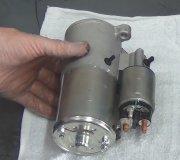Good afternoon.
You have air in the system. It is tough to bleed these systems.
Did it run out of fluid while you were doing the repair?
Roy
Note: Under normal conditions, disconnecting the clutch coupling will not introduce air into the system. However, if there appears to be air in the system, (spongy pedal, or insufficient bearing travel) the system must be bled. The largest portion of bleeding is carried out by gravity.
Removal and installation:
1. Disconnect coupling at transmission with Clutch Coupling tool No. T88T-70522-A or equivalent by sliding white plastic sleeve toward clutch slave cylinder while applying a slight tug on clutch tube.
2. Clean dirt and grease from around the reservoir cap.
3. Remove cap and diaphragm, then fill reservoir to step with Heavy Duty Brake Fluid part No. C6AZ-19542-AA or -BA (ESA-M6C25-A) or equivalent. Brake fluid must be certified DOT 3 or 4 specification.
4. Using a screwdriver, depress internal mechanism of male coupling to open valve. While continuing to hold valve open, slowly depress and hold clutch pedal to floor.
5. Remove screwdriver from coupling, closing valve. Release clutch pedal.
6. Refill reservoir to level at step, then repeat Steps 4 and 5.
7. Close reservoir. Reconnect coupling to clutch slave cylinder. Check that connection is secure by applying a slight tug to clutch tube.
8. Stroke clutch pedal as rapidly as possible 5 to 10 times, wait one to three minutes, then repeat three more times.
9. Loosen bleed screw (located in clutch slave cylinder next to inlet connection), then depress and hold clutch pedal while tightening bleed screw.
10. Refill clutch master cylinder reservoir to level at step.
Tuesday, May 15th, 2018 AT 12:44 PM



